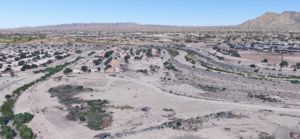With the leadership of Pima County employees Marie Light, Evan Canfield, and Julie Robinson, the second most populous county in Arizona recently approved funding for the Green Infrastructure Plan, which aims to optimize the use of stormwater to build a resilient urban ecosystem that reduces flooding and pollution.
To help make the case for the plan, a Triple Bottom Line Cost Benefit Analysis (TBL-CBA) using Autocase captured and quantified the social and environmental benefits of two green infrastructure/low impact development pilot projects designed by Wheat Design Group. These analytics provided key decision-making data for county officials to approve the plans, which came in early September.
The calculations for both projects compared the low impact development designs to alternate scenarios and showed significant long-term financial, social, and environmental gains.

The first project, Meander Bend Park, compared a green designed 18-acre park adjacent to the Santa Cruz River vs. a do-nothing scenario. The green design plan for the park offers:
– An enhanced existing recreational trail, providing recreational and property value benefits to residents
– Carbon reduction benefits and air quality improvements
– Other social benefits, including: food harvesting value, reduced effects from extreme heat waves, as well as water quality benefits.

The TBL-CBA showed environmental and social benefits that are more than 6x the costs of capital expenses and operation and maintenance.
 For the second site, the 0.3-acre Southern Arizona Children’s Advocacy Center (SACAC), TBL-CBA compared a parking lot to a green designed outdoor space with access to a recreational trail. In addition, two irrigation scenarios were compared.
For the second site, the 0.3-acre Southern Arizona Children’s Advocacy Center (SACAC), TBL-CBA compared a parking lot to a green designed outdoor space with access to a recreational trail. In addition, two irrigation scenarios were compared.
The analysis calculations provided by Autocase, showed that the green design—even with irrigation included—was less expensive than the parking lot. It forecasts a triple bottom line net present value of $1.13 million over a 50-year period.
Importantly, Autocase modeling accounted for rising temperature estimates based on data from University of Arizona scientists. The TBL-CBA results found that the value of vegetation to the urban heat island effect doubles when accounting for climate change.
A report on the projects, released by Pima County, notes the value added by Autocase, stating that it “offers great potential in generating triple-bottom line cost-benefit analyses, which have been difficult if not impossible to accomplish in the past.” Going forward, the county plans to use Autocase to quantify triple bottom line benefits of future preliminary project designs.
0 Comments